ME 755-756 and TECH 797 Senior Design Projects
A two-semester senior design project course (ME 755-756 or TECH 797) must be completed by the end of the senior year by all undergraduates who are planning to receive their bachelors degree in Mechanical Engineering or Ocean Engineering. The purpose of this requirement is to allow every M.E. and O.E. student to gain experience in a substantial design or experimental research project.
M.E. 755-756 Projects
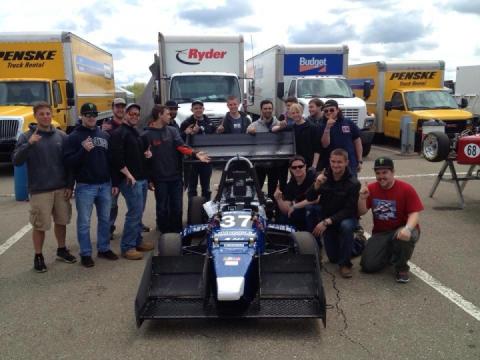
Each year, the University of New Hampshire has had a group of CEPS students design, manufacture and race an open wheel race car at a Society of Automotive Engineers (SAE) competition. This competition consists of both static and dynamic events. The static portion makes up approximately a third of the overall score, where the dynamic portion makes up the remaining two thirds. The static portion includes a cost event, business presentation, and an overall design evaluation. The dynamic events include an acceleration test, a figure eight, a one lap race, an endurance race, and a fuel efficiency test. The team is divided into subgroups; each responsible for selecting designs, and integrating them with the rest of the car. The subgroups for the UNH Precision Racing Team are typically frame, suspension, powertrain, aerodynamics, controls, and electronics. The overall designs of these subgroups include a lightweight, reliable and competitive car. At the beginning of the year, the team set two overall goals: finish the endurance portion of the competition, and finish the highest in school history.

The UNH Baja SAE team is a group of Mechanical Engineering students tasked with the design and construction of a one-man off-road vehicle for competition hosted by the Society of Automotive Engineers (SAE). The team is split into four groups: frame, suspension, controls and drivetrain in order to facilitate design such that all aspects are covered in a timely manner and with appropriate analysis. The students are involved in the entire span of the project, from fundraising and design to the construction and competition. Each group must work alongside the others in order to create a cohesive final design that is not only able to be driven, but complies with a list of rules set forth by the SAE. During the design process, emphasis is put on creating a vehicle with low cost and ease of manufacture, as these are judged as strongly in competition as the vehicle’s performance. Upon completion of the vehicle, the team travels to competition to compete with other institutions worldwide in a series of static events such as: design inspection and sales pitch, and dynamic events such as: hill climb, acceleration, maneuverability, suspension and endurance.
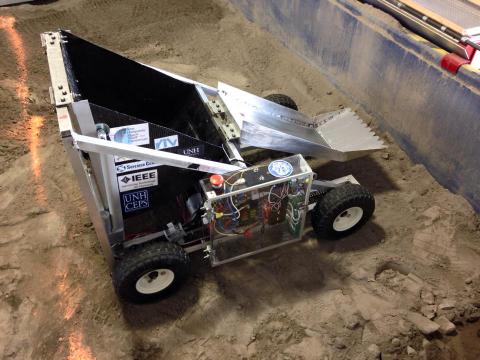
Every spring, the UNH LunaCats team travels to the Kennedy Space Center to partake in the NASA Robotic Mining Competition. This competition challenges university teams to design, build, and test a mining robot that could function on the surface of Mars. An autonomous mining robot was designed and built to mine 10kg of regolith in 10 minutes, navigate an obstacle field, and return to base. The robot utilizes image recognition technology and a path optimization learning algorithm to navigate through a simulated Martian environment.
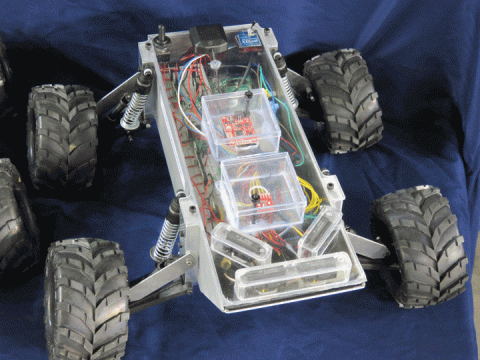
ET-NavSwarm’s mission is to design, build, and test 15 autonomous robots. These will serve as a testing platform for two graduate research algorithms: Particle Swarm Optimization (PSO) and Celestial Navigation (CelNav). PSO is derived from the concept of swarm behavior found in nature (birds, bees, etc.). By communicating and using mathematical principles, the swarm can find the best/most of a given objective within a specified area. The swarm operates without a centralized leader to search for natural resources, signs of life, or items of interest. CelNav uses a planet’s gravity and light from the local star field to determine latitude, longitude, and heading in the absence of a planetary global positioning system (GPS). The robots are designed to traverse rugged terrain, climb 45 degree inclines, avoid obstacles, and collect data on position and elevation. To accomplish this, they were made to be water-resistant and have the longest possible run time (battery life). The robots’ sensors and electronics were selected to fulfill the requirements of each algorithm. As a proof of concept for NASA, ET-NavSwarm will perform a large-scale field test with these 15 robots, searching for the highest and lowest elevations.
Tech 797 - Undergraduate Ocean Research Projects
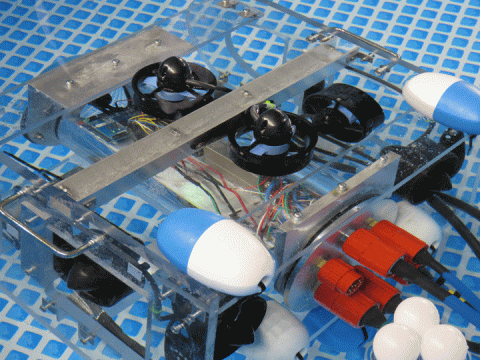
UNH ROV is an interdisciplinary engineering team focused on designing, fabricating, and competing with an underwater Remotely Operated Vehicle (ROV). UNH ROV pairs as a senior design project and a student organization while supporting graduate level research. The design incorporates a high degree of modularity by accounting for constraints defined by the international MATE ROV Competition as well as PhD research specifications involving autonomous Unmanned Underwater Vehicle (UUV) control. The MATE ROV Competition features 3 missions which have unique objectives relating to an arctic theme, while the research involves using an optical feedback system for pose control of multiple UUVs. Each part of the design is conceived using 3D modeling software, analyzed using finite element simulation packages, and verified through a prototyping and testing process. UNH ROV also focuses on maintaining a diverse team of freshman to graduate level students to maximize innovative and creative design. By using cutting-edge methods in team dynamics, analytic tools, and engineering design, UNH ROV is able to maintain continued success in developing underwater robotic systems used for multiple different platforms for research and competition.
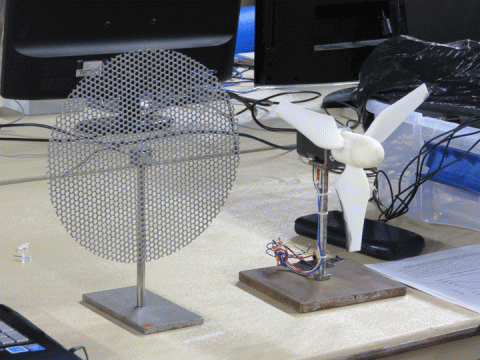
The interaction between wind turbines in a large wind farm needs to be better understood to reduce array losses and improve energy production. A numerical test bed for an array of offshore wind turbines was developed in the computational fluid dynamics (CFD) framework OpenFOAM. It provides a computational tool which can be used in combination with physical model turbine array studies in the Flow Physics Facility (FPF) at UNH. Turbines were modeled as actuator disks with turbulence sources to reduce computational cost. Both k-? and k-? SST turbulence models were selected to capture the flow in the near-wall, wake, and free stream regions. Experimental studies were performed in the FPF to validate the numerical results and to provide realistic initial and boundary conditions, for example turbulent boundary layer inlet velocity profiles. Mesh refinement and boundary condition studies were performed. Numerical simulations were executed on a custom-built server, designed to be the head node of a future CFD cluster. The entire project was built on open-source software to facilitate replication and expansion. The numerical model currently replicates a three by one array of wind turbines in the FPF, and provides detailed insight into the array fluid dynamics.

The Wave Energy Conversion Buoy (WECB) is a senior design project. The WECB team’s goal is to design and construct a point absorber wave energy device, which will generate electrical power from ocean waves. A point absorber buoy generates power by using the relative motion between two buoys (the middle spar buoy and the follower “donut” buoy) to drive a dual rack and pinion gear system that in turn spins a generator. The intent of the project is to demonstrate wave energy as a viable source of renewable energy for powering the Shoals Marine Laboratory located on Appledore Island, Isles of Shoals, off the coast of Maine and New Hampshire.